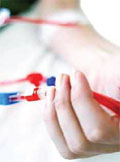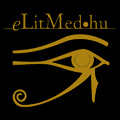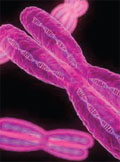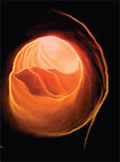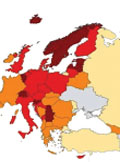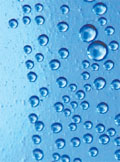The eLitMed.hu medical portal uses computer cookies for convenient operation. Detailed information can be found in the Cookie-policy.
Lege Artis Medicinae - 2012;22(02)
Content
[The role of antilipidaemic therapy in chronic kidney disease]
[In chronic kidney disease (CKD), the risk of cardiovascular mortality is remarkably high, which is partly due to lipid alterations. The results with statin treatment in cardiovascular prevention studies and in CKD, and their metaanalysis show that antilipidaemic therapy decreases overall and cardiovascular mortality in the predialysed state. On the basis of the new study SHARP, coadministration of simvastatin plus ezetimib also significantly reduces the number of atherosclerotic events in predialysed CKD (this was the first positive hard-endpoint result regarding the combination), thus it can be considered as an alternative. A large-scale metaanalysis of two earlier studies assessing the dialysed patients and patients of the SHARP study who received only dialysis indicated that antilipidaemic therapy was successful, as the number of nonfatal myocardial infarctions and coronary revascularisation interventions have been significantly reduced. These new results also show that in patients who need dialysis, the efficiency of statin or statin plus ezetimib therapy is decreased compared to predialysed state - owing to the partly different pathomechanism -, but this antilipidaemic therapy - especially in those with a high cardiovascular risk - can reduce the incidence of cardiovascular events.]
[The risk of nonsteroidal antiinflammatory drugs]
[During the past ten years, a number of original publications, reviews and metaanalyses were published on the cardiovascular (CV) safety of nonsteroidal antiinflammatory drugs (NSAIDs). These data were summarised in several previous publications. As this group of medicines is very frequently used and many of them are available over the counter (OTC), their risks require particular attention. Recently, new analyses have been published on previously discussed preparations as well as on new drugs that had been omitted from previous analyses (paracetamol, aceclofenac), thus, it is important to review these data and draw attention again to differences in side effects among NSAIDs.]
[Potentials and limitations of the application of RNA interference]
[The discovery of RNA interference revolutionised our knowledge about regulation. Small interfering RNA sequences, which have a central role in this phenomenon, go through a complex maturation process. By means of their antisense effect, they result in the degradation of homologuous RNA sequences or transcriptoinal repression in the cell. Due to its advantages, the application of gene silencing has rapidly become prevalent in basic research, especially in the field of molecular biology. Besides, an increasing effort has been made to utilise it in certain incurable diseases, viral infections, neurodegenrative disorders as well as in oncological diagnostics and therapy. However, in the interest of safe application, researchers in this area call our attention to the importance of answering a number of questions.]
[Non-HDL-cholesterol and its significance]
[The role of LDL-cholesterol in cardiovascular risk has been established in a number of studies. According to current recommendations, therefore, the primary goal of lipidlowering therapy is reducing the level of LDL-cholesterol. Of lipid-lowering drugs, statins are the most efficient in reducing cardiovascular risk. According to large studies on statins, however, there is a significant residual risk even in patients receiving aggressive treatment. It is well known that many patients continue to have dyslipidaemia despite statin therapy, and not all patients with cardiovascular disease have elevated LDL-cholesterol levels. These observations indicate that lipids other than LDL-cholesterol also have a role in the development of atherosclerosis. A growing attention is paid to non-HDL-cholesterol as a cardiovascular risk factor. Calculating non-HDL-cholesterol target is easy: LDL-cholesterol measurement plus 0,8. Non-HDL-cholesterol incorporates a number of atherogenic lipoprotein particles [VLDL-cholesterol, IDL-cholesterol, LDL-cholesterol, and lipoprotein(a)]. As the atherogenic effect of apoB-containing lipoproteins (LDL, IDL-C és VLDL) is significant, they may be stronger predictors of coronary heart disease (CHD) risk than LDL-cholesterol is. Considering the strong correlation between apoB and non-HDLcholesterol and the limitations of apoB measurement (standardisation, cost), non- HDL-cholesterol is a more useful parameter and therapeutic target, especially if triglyceride levels are greater than 2.26 mmol/l.]
[Current status of the laboratory diagnosis of tuberculosis in Hungary]
[In the past decade, the epidemiological status of tuberculosis has significantly improved in Hungary. The incidence is today lower than 20 per 100 000 inhabitant, therefore, the laboratory network performing diagnosis needs to look for new challenges. As the yearly number of cases decreases, less examinations will be needed, but a greater emphasis should be placed on shortening the time needed for diagnosis, more efficient culturing, resistance tests and molecular typing performed for epidemiological purposes. Our aim is to provide an overview of the status of the diagnostic network of tuberculosis in Hungary and the future challenges it faces, on the basis of data published by the National Korányi Institute of TBC and Pulmonology and the European Centre for Disease Prevention and Control.]
[The diagnostic value of a glass of soda water in case of a cardiac space-occupying lesion]
[INTRODUCTION - Large hiatal hernias may result in cardiac space-occupying lesions. Our case study discusses the clinical aspects and the possible diagnostic approaches for such large hiatal hernias that cause cardiac compression. CASE REPORT - In an elderly patient with no cardiovascular symptoms, transthoracic echocardiography revealed a left atrial space-occupying mass. The diagnosis regarding the origin of the cardial mass was clarified by a glass of soda water drunk by the patient during echocardiography, as it resulted in a decrease in the inhomogenous echodensity of the mass and the appearance of “contrast bubbles” within it. This phenomenon suggested the presence of a large hiatal hernia compressing the heart, which was confirmed by gastroscopy and upper gastrointestinal barium examination. CONCLUSION - Drinking soda water during transthoracic echocardiography can help to diagnose lesions that look like intracardial tumours.]
[Written and pictorial content in magazines and their possible relationship to eating disorders]
[In the current study we reviewed the literature on studies exploring the magazine reading frequency, written and pictorial contents appearing in magazines and their connection to eating disorders. Reading different fashion and fitness magazines has effect on readers through several indirect and direct factors and through trustable and false information. They affect readers' body satisfaction, self-esteem, eating habits and more generally their health behavior. Different theories have been explained to account for these associations and several other studies examined empirically the connection between the frequency of magazine reading and eating disorders, as well as the symptoms leading to eating disorders. METHODS - We analyzed and summarized articles between 1975 and 2009 from online databases. We used the following sources: Science Direct (http://www.sciencedirect. com/), Springer-Verlag GmbH (http://www.springerlink.com/) and SAGE Publications Ltd (http://online.sagepub. com/). RESULTS - The pictorial and written magazine contents were associated with the development and maintenance of eating disorders or with symptoms that might lead to eating disorders. The publications comparing to previous years found elevated number of unhealthy food advertisements, unhealthy and radical diet plans and exercise programs. Furthermore the magazines contained conflicting messages about nutrition, body functions and eating disorders. CONCLUSION - Written and pictorial magazine contents, messages might increase the risk for development of eating disorders, especially in vulnerable individuals.]
1.
Clinical Neuroscience
[Headache registry in Szeged: Experiences regarding to migraine patients]2.
Clinical Neuroscience
[The new target population of stroke awareness campaign: Kindergarten students ]3.
Clinical Neuroscience
Is there any difference in mortality rates of atrial fibrillation detected before or after ischemic stroke?4.
Clinical Neuroscience
Factors influencing the level of stigma in Parkinson’s disease in western Turkey5.
Clinical Neuroscience
[The effects of demographic and clinical factors on the severity of poststroke aphasia]1.
2.
Clinical Oncology
[Pancreatic cancer: ESMO Clinical Practice Guideline for diagnosis, treatment and follow-up]3.
Clinical Oncology
[Pharmacovigilance landscape – Lessons from the past and opportunities for future]4.
5.




